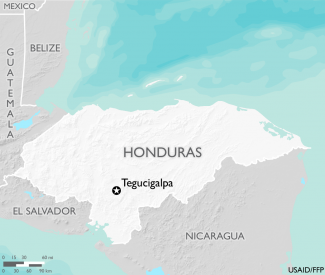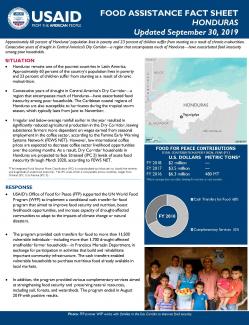September 30, 2019
Approximately 60 percent of Honduras’ population lives in poverty and 23 percent of children suffer from stunting as a result of chronic malnutrition. Consecutive years of drought in Central America’s Dry Corridor—a region that encompasses much of Honduras—have exacerbated food insecurity among poor households.
Situation
- Honduras remains one of the poorest countries in Latin America. Approximately 60 percent of the country’s population lives in poverty and 23 percent of children suffer from stunting as a result of chronic malnutrition.
- Consecutive years of drought in Central America’s Dry Corridor—a region that encompasses much of Honduras—have exacerbated food insecurity among poor households. The Caribbean coastal regions of Honduras are also susceptible to hurricanes during the tropical storm season, which typically lasts from June to November.
- Irregular and below-average rainfall earlier in the year resulted in significantly reduced agricultural production in the Dry Corridor, leaving subsistence farmers more dependent on wages earned from seasonal employment in the coffee sector, according to the Famine Early Warning Systems Network (FEWS NET). However, low international coffee prices are expected to decrease coffee sector livelihood opportunities over the coming months. As a result, Dry Corridor households in Honduras are projected to face Stressed (IPC 2) levels of acute food insecurity through March 2020, according to FEWS NET.
* The Integrated Phase Classification (IPC) is a standardized tool that aims to classify the severity and magnitude of food insecurity. The IPC scale, which is comparable across countries, ranges from Minimal (IPC 1) to Famine (IPC 5).
Response
- USAID’s Office of Food for Peace (FFP) supported the UN World Food Program (WFP) to implement a conditional cash transfer for food program that aimed to improve food security and nutrition, boost livelihoods opportunities, and increase capacity of drought-affected communities to adapt to the impacts of climate change or natural disasters.
- The program provided cash transfers for food to more than 11,500 vulnerable individuals—including more than 1,700 drought-affected smallholder farmer households—in Francisco Morazán Department, in exchange for participation in activities that build and rehabilitate important community infrastructure. The cash transfers enabled vulnerable households to purchase nutritious food already available in local markets.
- In addition, the program provided various complementary services aimed at strengthening food security and preserving natural resources, including soil, forests, and watersheds. The program ended in August 2019 with positive results.
Food for Peace Contributions
Total Contributions:
| U.S. Dollars | Metric Tons | |
|---|---|---|
| Fiscal Year 2018 | $2.0 million | --- MT |
| Fiscal Year 2017 | $3.5 million | --- MT |
| Fiscal Year 2016 | $6.3 million | 480 MT |
* Metric tonnage does not reflect funding for vouchers or cash transfers.
Related Resources


